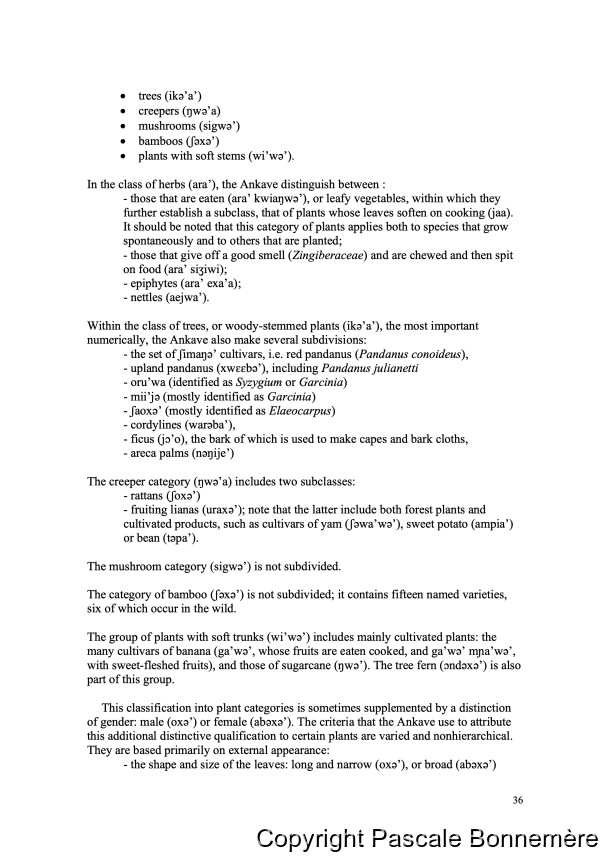|
|  [Note: this transcription was produced by an automatic OCR engine]
trees (1ko’a’)
creepers (nwo’a)
mushrooms (sigwo”’)
bamboos (fox9’)
plants with soft stems (w1i’wo”).
In the class of herbs (ara”), the Ankave distinguish between :
- those that are eaten (ara’ kwianwo”), or leafy vegetables, within which they
further establish a subclass, that of plants whose leaves soften on cooking (jaa).
It should be noted that this category of plants applies both to species that grow
spontaneously and to others that are planted;
- those that give off a good smell (Zingiberaceae) and are chewed and then spit
on food (ara” si3iwi);
- epiphytes (ara” exa”’a);
- nettles (aejwa’).
Within the class of trees, or woody-stemmed plants (1ko’a”), the most important
numerically, the Ankave also make several subdivisions:
- the set of fimano” cultivars, 1.e. red pandanus (Pandanus conoïideus),
- upland pandanus (xwæeebs”’), including Pandanus julianetti
- oru’wa (identified as Syzygium or Garcinia)
- mi’jo (mostly identified as Garcinia)
- faoxo” (mostly identified as Elaeocarpus)
- cordylines (waroba’),
- ficus (j9’0), the bark of which is used to make capes and bark cloths,
- areca palms (nonije’)
The creeper category (nwo’a) includes two subclasses:
- rattans (ox)
- fruiting lianas (uraxo”); note that the latter include both forest plants and
cultivated products, such as cultivars of yam (fowa’wo”), sweet potato (ampia’)
or bean (topa’).
The mushroom category (sigwo’) is not subdivided.
The category of bamboo (fox) is not subdivided; it contains fifteen named varieties,
six of which occur in the wild.
The group of plants with soft trunks (w1’ws”) includes mainly cultivated plants: the
many cultivars of banana (ga”’wo’, whose fruits are eaten cooked, and ga’wo’ mna’ws,
with sweet-fleshed fruits), and those of sugarcane (nwo”). The tree fern (ondoxo’) is also
part of this group.
This classification into plant categories is sometimes supplemented by a distinction
of gender: male (ox9”) or female (aboxo”). The criteria that the Ankave use to attribute
this additional distinctive qualification to certain plants are varied and nonhierarchical.
They are based primarily on external appearance:
- the shape and size of the leaves: long and narrow (ox9°), or broad (abs5xs”)
36
�
|